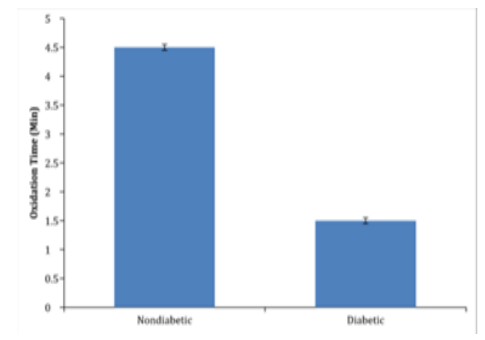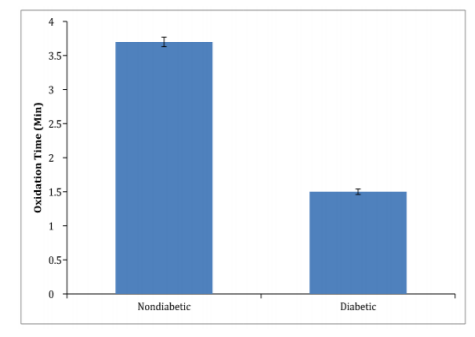Information
Journal Policies
Comparative Studies on the Effects of Ethyl Nitrite and Hexyl Nitrite Induced Hemoglobin Oxidation of Diabetics Blood and Normal Blood
John Philip Tarburton
Copyright : © 2017 Authors. This is an open-access article distributed under the terms of the Creative Commons Attribution License, which permits unrestricted use, distribution, and reproduction in any medium, provided the original author and source are credited.
The effect of ethyl nitrite on human Type 2 diabetics blood was undertaken using non-diabetics blood as the control group. These studies revealed that diabetics erythrocytes were oxidized at a significantly greater rate than the control blood (P< 0.05). The ethyl nitrite mean oxidation time ± SEM of diabetics blood was 1.5 ± 0.05 min (sample size (n) is 20) and the mean oxidation time ± SEM of the non-diabetics blood was 4.5 ± 0.05 min (n=20). Next the effect of hexyl nitrite on human Type 2 diabetics blood was undertaken using non-diabetics blood as the control group. It was revealed that diabetics erythrocytes were oxidized by hexyl nitrite at a significantly greater rate than control erythrocytes (P< 0.05). The mean oxidation time ± SEM of the diabetics blood was 1.5 ± 0.04 min (n=20) whereas the mean oxidation time ± SEM of the non-diabetics blood was 3.7 ± 0.07 min (n=20). Thus, these studies demonstrate that diabetics blood has an enhanced susceptibility of oxidation into methemoglobin by both ethyl nitrite and hexyl nitrite compared to their respective control groups. This similar finding could be attributed to the fact that both ethyl nitrite and hexyl nitrite are organic nitrites wherein the hexyl nitrite contains a saturated six hydrocarbon chain and ethyl nitrite contains a saturated two hydrocarbon chain. Thus the difference of four methylene molecules had no statistically significant effect on the rate of oxidation on either human diabetics blood or human non-diabetics blood (P>0.05).
1. Introduction
Both ethyl nitrite and hexyl nitrite belong to a class of compounds called alkyl nitrites that cause oxyhemoglobin to undergo oxidation, i.e. the iron (II) in the hemoglobin loses an electron to become iron (III) and cannot carry oxygen to the tissues and is therefore useless in oxygen transport to the tissues [1]. Nitrites are compounds that have long been known to induce this oxidation reaction [2].
In addition both ethyl nitrite and hexyl nitrite are used as inhalants which are inexpensive and easy to obtain but can cause the heart to beat quickly and irregularly and then suddenly stop (cardiac arrest). An overdose via ingestion, rather than inhalation, may result in cyanosis and even death from methemoglobinemia [3-6]. With wide usage of alkyl nitrites for both medicinal and recreational uses and possible side effects there from a study of diabetics blood due to their increased susceptibility by amyl nitrite [7,8] appears warranted.
2. Materials And Methods
Hexyl nitrite (≥ 95%) was purchased from Fisher Scientific. Ethyl nitrite (10-20 wt. % in ethanol) was purchased from the Sigma-Aldrich Chemicals Company. Other required chemicals were obtained from Fisher Scientific. Blood products such as normal adult blood and diabetics’ blood were purchased from Physicians Plasma Alliance (PPA). The procedures followed by PPA for this sample collection study were in accordance with the ethical standards of the Hummingbird IRB Protocol wherein all subjects used in these studies gave voluntary informed consent. All blood was tested and certified to be non-viral by PPA.
For both alkyl nitrite studies: the data were obtained from 40 donors 20 of whom had type 2 diabetes mellitus and 20 of whom were non-diabetics. The samples were provided as matched sets of diabetics and non-diabetics blood wherein the two groups were matched with respect to age, gender, number of obese and number of cigarette smokers as evenly as possible. Also these donors took similar vitamins and medications according to their medical histories. In Tables 1-4 the characteristics of the patients used in these studies are presented, i.e., HbA1C, age, gender, weight and smoker status are noted. All blood was drawn into Acid-Citrate-Dextrose (ACD) tubes and stored at 2-4 C prior to use.
A 0.01 mL portion of resuspended RBCs was hemolyzed by the addition of 1.0 mL of distilled water and adjusted to a final volume of 2.6 mL by the addition of 20 mM PBS (pH 7.2). The hemoglobin solutions were then adjusted to a standard absorbance (e.g., A = 1.0 ± 0.2) at a wavelength of 436nm with more 20 mM PBS (pH 7.2). The 2.6 mL aliquot of this hemoglobin solution was then added to a 0.05 mL aliquot of 0.1% ethyl nitrite (or 0.1% hexyl nitrite) in ethanol solution. A final concentration of 38 μmol/L of ethyl nitrite (or 138 μmol/L for hexyl nitrite) was obtained after its addition to the hemoglobin solution. In both studies the above gave a final hemoglobin concentration between 6 and 9 μmol/L [10].
All of the above solutions were then placed in cuvettes and the reaction measured in a spectrophotometer equipped with a chart recorder set at a wavelength of 436 nm. This is a suitable wavelength for measuring and distinguishing oxyhemoglobin and methemoglobin. The spectrophotometer chart recorder then generated graphic representations of the conversion of oxyhemoglobin into methemoglobin as a function of time. The terminal period or asymptotic phase corresponds to essentially 100% methemoglobin formation. The final absorbance was found to be approximately A = 0.5 ± 0.1. All hemoglobin oxidation times (in min) obtained have been included in Tables 1-4 for these samples.
According to Colton [11] the appropriate test to use for these data is the Student's t-test for independent samples. The data was analyzed using an Excel spreadsheet on a Microsoft computer. The significance level has been considered to be P< 0.05.
3. Results And Discussion
For the alkyl nitrite studies the findings of the HbA1C percentages revealed that the diabetics blood mean ± standard error of the mean (SEM)was12.2 ± 0.31%, while that of the nondiabetics blood had a mean ± SEM of 5.5 ± 0.05%. Thus, the percentage differences between the two populations was statistically significant (P<0.05), and this means that these two populations are good groups on which to undertake the alkyl nitrite oxidation studies as is shown in the column comparison of the means ± SEM in Figure 1 [11].
For ethyl nitrite the mean oxidation time of the diabetics blood ± SEM was 1.5 ± 0.05 min whereas the mean oxidation times of the non-diabetics blood ± SEM was 4.5 ± 0.05 min as shown in the column comparison of the mean ± SEM in Figure 2. Based on an independent Student’s t-test, the time taken for diabetics erythrocytes to undergo oxidation was significantly shorter (P<0.05) than the nondiabetic controls. For hexyl nitrite the mean oxidation time ± SEM of the diabetics blood was 1.5 ± 0.04 min whereas the mean oxidation times ± SEM of the non-diabetics blood was 3.7 ± 0.05 min as shown in the column comparison of the mean ± SEM in Figure 3. Based on an independent Student’s t-test, the time taken for diabetics erythrocytes to undergo oxidation was significantly shorter (P< 0.05) than the non-diabetic controls. This similar finding could be attributed to the fact that both ethyl nitrite and hexyl nitrite are organic nitrites that contain saturated hydrocarbon chains. Interestingly, the enhanced susceptibility to both alkyl nitrite induced oxidation reactions occurred in Type 2 diabetics blood which implies that HbA1C oxidation to methemoglobin is a direct function of the amount of HbA1C present as opposed to metabolic differences in the Type 1 and Type 2 diabetes [12]. Essentially, any untreated diabetic simply has a greater percentage of HbA1C than a non-diabetic, e.g. 12.2% vs. 5.5% in this study as shown in Figure 1. Thus, these preliminary findings indicate that diabetics have hemoglobin that exhibit greater oxidative stress to alkyl nitrite owing to a higher percentage of HbA1C.
References
- Dan Longo, et al. (2012) Harrison's Principal's of Internal Medicine. 18th ed.. Vol. 1 McGraw Hill, New York, NY 857-858.
- Kiese M. Methemoglobinemia: a Comprehensive Treatise: Causes, Consequences, and Correction of Increased Contents of Ferrihemoglobin in Blood. CRC Press. Cleveland, Ohio; 1974.
- Chilcote RR, Williams B, Wolff LJ, Baener RL (1977) Sudden death in an infant from methemoglobinemia after administration of "sweet spirits of nitre". Pediatrics 59:280-282.
- Bernasconi B, Konrad C, Fischer S (2014) Case Report - A dangerous intoxication after ingestion of alkyl nitrite ('poppers'). Anästhesiol Intensivmed Notfallmed Schmerzther 49: 654-658.
- Hall A, Stessel B, Bergmans D, Schnabel R (2012)Twocasesofacquired methemoglobinemia. Acta Anaesth Belg 63:97-100.
- Clayton GD, Clayton FE (eds.) (1994) Three cases of ethyl nitrite intoxication have been reported. Patty's Industrial Hygiene and Toxicology. Volumes 2A-2F: Toxicology. 4th ed. John Wiley & Sons, New York p 655.
- Tarburton J (2013) Amyl nitrite induced hemoglobin oxidation studies in diabetics and nondiabetics blood. J Diabetes and Metabolism 4: 258-260.
- Tarburton JP (2014) Hemoglobin oxidation studies in diabetics blood comparing the effect of sodium nitrite vs. amyl nitrite. Diabetes Research and Treatment 2014 1:112-117.
- National Diabetes Fact Sheet (2011) U.S. Department of Health and Human Services, Centers for Disease Control and Prevention.
- Weissbluth M (1974) Hemoglobin: Cooperativity and electronic properties. In: Kleinzellar A, Springer GF, Whitman HG (eds), Molecular Biology, Biochemistry and Biophysics, Vol 15 Sringer-Verlag, New York 136-141.
- Colton T. Statistics in Medicine. Little, Brown and Co. Boston, MA; 1974: pp. 99-150 and 207-211.
- Moussa SA (2008) Oxidative stress in diabetes mellitus. Romanian Journal of Biophysics 18: 225-236.







